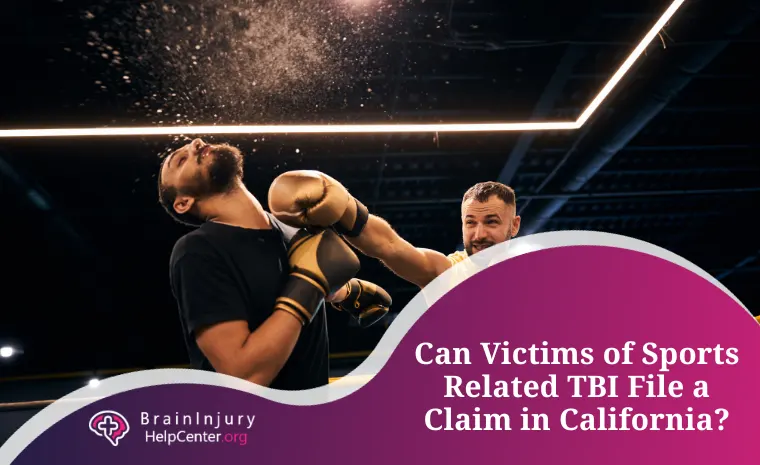Can Victims of Sports Related TBI File a Claim in California?
Sports play a significant role in our lives, promoting physical fitness, teamwork, and healthy competition. However, the pursuit of excellence on the field comes with inherent risks, one of the most severe is traumatic brain injury (TBI).
This blog aims to shed light on what TBIs are, how they can occur in sports settings, and how California’s legal provisions address such injuries. We will look into the criteria for filing a claim, including liability, negligence, and potential defenses, while using real-life examples to illustrate key points. Seeking legal counsel is a must in navigating brain injury claims.
Suffered a TBI from a sports-related accident?
Understanding TBI
A TBI is a complex and potentially devastating condition that occurs when the brain’s normal function is disrupted due to a forceful impact to the head. The severity of TBIs can vary widely, ranging from mild to severe head injuries with long-lasting consequences. In sports settings, where high-speed biomechanical forces and physical contact are common, TBIs can be a significant concern.
Common Types of TBI
- Cerebral Concussion: Concussive injuries are the most common type of TBI in sports. They result from a sudden jolt or blow to the head that causes the brain to move rapidly within the skull.
- Contusion: Contusions are bruises on the brain caused by direct impact. These can result in subdural hematoma (brain bleed) and swelling, potentially leading to more severe complications.
- Penetrating Injury: This occurs when an object penetrates the skull and directly damages the brain tissue. While less common in sports, it’s a grave concern when it does happen.
- Diffuse Axonal Injury: This occurs when the brain rapidly shifts inside the skull, causing nerve fibers to tear. It often leads to widespread brain damage and can have long-term effects on cognitive and motor functions.
- Related Neck injuries and cervical cord injuries
TBI Symptoms
Clinical symptoms of TBI can vary depending on the severity of the injury. They can manifest immediately or develop gradually over time. Common symptoms include:
- Headaches or migraines
- Dizziness or loss of balance
- Nausea or vomiting
- Confusion
- Cognitive symptoms and memory problems
- Mood swings or irritability
- Sensitivity to light or noise
- Sleep disturbances
- Double vision
TBIs in Sports Settings
Athletes are particularly susceptible to TBIs due to the nature of physical activities and contact sports.
- Football: High-impact sports like football often involve forceful collisions, increasing the risk of head injuries. Tackles and collisions during games or practices can lead to sport-related concussions and other types of TBIs.
- Soccer: Soccer players may experience head injuries when attempting headers or colliding with other players during matches. Heading the ball repeatedly, especially at a young age, has raised concerns about the long-term effects of sport-related head injuries.
- Hockey: Ice hockey involves rapid movement and physical contact. Players can sustain TBIs from body checks, collisions with the boards, or fights.

Sports-Related TBI: California’s Legal Perspective
As reported by the National Safety Council (NSC), there are approximately 3,018,656 injuries in 2021 in the United States. Exercise equipment-related accidents are at 14% injury rate, making it the leading cause of injuries among all categories of professional and school sports plus recreational activities. The same data showed that in California alone, there are 125 pedalcyclist who died related to athletic activities.
Like many other states, California recognizes the potential dangers of sports-related TBIs and has taken steps to address them. The Youth Sports Concussion Protocol Act or Cal Health and Safety Code §124235 requires school-sponsored youth sports programs to adopt protocols for addressing concussions and other head injuries. This ensures that athletes who sustain head injuries are properly evaluated and cleared by healthcare professionals before returning to play.
The act encompasses several important components:
- Mandatory Protocols: The act mandates that all school-sponsored youth sports programs in California must develop and implement sports-related concussion protocols. These protocols outline the necessary steps to be taken when an athlete sustains a head injury during practice or competition.
- Proper Evaluation: One of the core aspects of the act is the requirement for athletes who sustain head injuries to undergo thorough and appropriate baseline testing and evaluation by qualified medical professionals. This evaluation is critical for accurately diagnosing the severity of the injury and determining the athlete’s readiness to return to play.
- Medical Clearance: Athletes who experience a head injury are not allowed to resume participating in sports until they receive clearance from a licensed medical professional specializing in sports-related concussion assessment and clinical management. Sometimes, neurocognitive testing may be necessary for those who experienced memory loss and slower reaction time. This ensures that athletes do not return to play prematurely and risk exacerbating their condition.
- Parental Notification: The act also emphasizes the importance of communication between schools, coaches, and parents or guardians. Parents must be promptly notified if their child sustains a head injury during a sports activity, ensuring transparency and informed decision-making.
Who is Responsible for a Sports-Related TBI?
Engaging in sports inherently involves physical activity, and the possibility of getting hurt is always present. If a school athlete or an American football player happens to injure a finger while lunging for a football or sprain your ankle during a sprint to first base, seeking compensation might not be feasible.
Nonetheless, if your injury is a result of actions that surpass the ordinary expectations of the activity, various parties might be held accountable, contingent upon the specific circumstances.
Potential parties that could be held liable include:
- Coaches
- Educational institutions and other affiliated organizations
- Fellow players
- Manufacturers
- Medical professionals
The most prevalent legal claim in cases of sports-related injuries is negligence. To substantiate a claim that negligence led to brain injury from sports, the following elements must be established:
- Duty of Care: The defendant had a responsibility toward you. In most scenarios, this duty implies the obligation to exercise “reasonable care”, including those done during complex training drills. In specific instances, a more tailored duty of care might be applicable.
- Breach of Duty: The defendant neglected their duty of care. This breach might occur, for instance, if you were prompted to return to a football game despite displaying clear indications of a concussion.
- Direct Result: Your injury directly resulted from the breach. The defendant’s actions or negligence must be the direct cause of your injury.
Additional legal avenues that could be pertinent in these cases are:
- Product Liability: This claim arises if a product like a running shoe or football helmet was defective or lacked proper warnings, leading to the injury.
- Medical Malpractice: In situations where a doctor failed to diagnose a condition accurately or provided incorrect advice, a medical malpractice claim might be relevant.
- Wrongful Death: If the sports-related injury proves fatal, a wrongful death claim might be suitable. This claim can be brought forth by specific family members of the deceased and is intended to compensate for the loss of a loved one.
Suffered a TBI from a sports-related accident?
Filing a Claim for TBI: Criteria and Considerations
When filing a claim for a sports-related TBI in California, several key factors come into play:
- Liability: To hold someone legally responsible for a TBI, it must be proven that their actions or negligence directly caused the injury. This could include coaches, trainers, or even other players who acted recklessly.
- Negligence: Negligence refers to the failure to exercise reasonable care. For a successful claim, it must be shown that the responsible party failed to take appropriate precautions to prevent the injury, considering the risks associated with the sport. Solid evidence must be presented, such as photos of the injury, list of daily activities and contact practice, medical report, estimated recovery time,
- Possible Defenses: Defendants might attempt to use defenses like assumption of risk, arguing that the injured person knew the risks associated with the sport and voluntarily participated anyway. However, this defense might not hold up if the defendant’s actions were grossly negligent.
Real-Life Cases
Case 1 – Former UCLA Players vs. School and Coach
A legal action was initiated by three former UCLA college football players who sued the university due to injuries they sustained during their time playing under the guidance of coach Jim Mora. According to a report, each of these players is seeking more than $15 million in compensation in relation to allegations that coaches and trainers mishandled their injuries.
The lawsuits, which were officially filed in 2019 in the Los Angeles Superior Court, specifically target former coach Jim Mora, offensive line coach Adrian Klemm, and associate trainer Anthony Venute.
Additionally, the legal action includes the UCLA regents and the NCAA as defendants. The offensive linemen in question, John Lopez and Poasi Moala, asserted that they endured traumatic head injuries during their time on the team and said that they are currently grappling with ongoing symptoms linked to chronic traumatic encephalopathy.
As of August 2022, one of the linemen agreed with the NCAA under a conditional settlement helping him recover his life back. No other reports for the two former players as of writing.
Case 2 – Junior Seau: A Case of Chronic Sports-Related TBI
Very few neurological reports have garnered as much widespread attention across the country as chronic traumatic encephalopathy (CTE), a condition that has been identified in the post-mortem examinations of concussed athletes, with professional football players being particularly notable.
The unfortunate instance of Junior Seau, an esteemed Hall of Fame linebacker in the National Football League under San Diego Chargers (now known as Los Angeles Chargers), stands out as the most prominent and verified case of CTE.
A wrongful death lawsuit was filed in relation to his head injury that led to his tragic suicide in 2012. Reports say that in 2018, the family of the late NFL superstar, Junior Seau, has reached a confidential resolution in their wrongful death lawsuit against the NFL, which helped his three kids move on with their lives.
Seeking Legal Action and Professional Advice
Traumatic brain injuries can have life-altering consequences. These can be a common yet sometimes neglected incident among athletes.
California’s legal provisions are designed to ensure that victims of sports-related TBIs have avenues for seeking recourse. By understanding liability, negligence, and potential defenses, victims can better navigate the legal landscape. If you find yourself in such a situation, remember that seeking advice from legal professionals is a crucial step toward achieving justice and securing your future.
If you or a loved one has suffered a TBI in a sports setting, it’s crucial to consult with a legal professional experienced in personal injury cases.
The Brain Injury Help Center can help you connect with award-winning personal injury lawyers who can assess the strength of your claim, guide you through the legal process, and advocate for fair compensation. Call us at (866) 576-0936.
Remember, your health and well-being are paramount. Our legal professionals can help you balance the pursuit of justice with your recovery.









